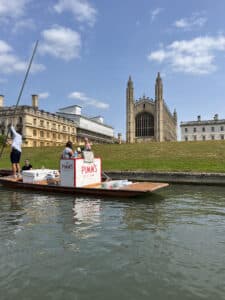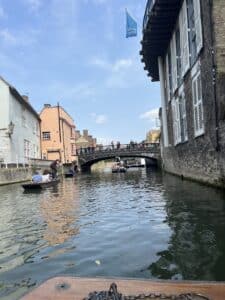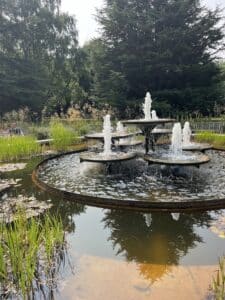
I’m gliding along the River Cam with my partner Terry, on an utterly romantic punt ride. The sun is glistening on the water and as we pass under the drooping willows Alex, our guide and punt driver, tells us to pick a leaf and make a wish. It’s a dreamy start to our two day visit to Cambridge. These flat bottomed boats make it easy to navigate the shallow waters and with comfortable tartan covers over our cushioned seats, easily the most luxurious way to enjoy punting.

Along the way Alex tells us stories about the famous Alumni from Cambridge University and points out interesting sites – such as the Bridge of Sighs and the awe inspiring arched Mathematical Bridge constructed entirely of straight planks. Scudamores Punts have been running since 1910 when Jack Scudamore thought of this novel way to enjoy the river – it has been a source of great enjoyment for decades with many people opting to hire punts and push themselves. Being the largest leisure punting operation with 250 boats, Scudamore’s is good value too from £24pp for an hour long tour.

After enjoying the must-do-activity on the water, we head to the bustling heart of the city on King’s Parade. It’s pedestrianised like much of the centre of the city for most of the day making it easy to stroll around. Here we wandered into The Chop House where some of the city’s most enticing meat dishes can be enjoyed. The Love Cambridge Card offers a host of eateries from coffee shops to fine dining and gives the hungry tourist a wide range of options. We went full English on lunch enjoying a slap up Sunday Roast for £20 and washed it down with a refreshing Pimm’s cocktail.
First impressions of Cambridge are of a well organised city with a history and heritage that’s treasured. The University of Cambridge is made up of thirty-one individually named colleges, each has an interesting past and many are open free for the public to wander around. We start our exploration of them on a guided walking tour led by the knowledgeable Yvonne from Cantabtours. Crowds throng the gateway of Kings College – for good reason – as the chapel has all the ambience of the Sistine chapel and the magnificent fan vaulted ceiling is the largest of its kind in the world. From Ruben’s masterpiece, ‘Adoration of the Magi’ at one end of the church to the impressive stained glass windows filling the chapel floors with dappled light this place is a marvel. Yvonne points out interesting details such as the stained glass effigy of Henry VIII portrayed as the infant Jesus. Henry ensured that Tudor symbolism with sculpted roses and crests adorned the walls. The choir of Kings College is synonymous with melodic evensong and famous Christmas Hymns – therefore only bespoke candles imported from Sweden burn in this hallowed place with the most sympathetic acoustics.

The name dropping becomes intense and flowing from the hugely informative Yvonne as we explore the other campuses spread throughout the city. I’m always intrigued by literary connections and some of the best known include EM Foster, Salman Rushdie and Sadie Smith to name just a few. The dark and macabre can also be found. At Sidney Sussex College, one of the oldest in the university, the remains of Oliver Cromwell came to a suitably grim end and are currently buried under the floor of the entrance to the chapel. Apparently his head turned up in a box decades after it had been exhumed from Westminster Abbey.
Trinity College is where Isaac Newton recorded the speed of sound and a descendant of the apple tree, under which he discovered the theory of gravity, is now growing at the gates. Another feature of Trinity is the Court in the centre of the college where the Great Court Run is hosted every year on the day of the Matriculation Dinner. The course is about 370 meters and takes 43.5 seconds to run – the time that the clock takes to strike twelve chimes. The spectacle features in the Oscar winning movie, Chariots of Fire, about the British Olympic team that included college students in 1924.

A first edition of Winnie the Pooh resides at The Wren Library where AA Milne spent time there as an undergraduate. In the early 1800s it was a different kind of bear that caused a stir when the poet Byron came to study at Cambridge. On learning that it’s forbidden to keep cats and dogs in the college, and having his own dog sent home, Byron promptly went to the next town where he bought a bear. He was frequently seen walking with his pet for the duration of his first year until the college changed the rules to include bears the following year. Other graduates from Trinity College include the current British King Charles the third whose attendance from 1967 was well broadcast at the time.

Along the way we pass Cambridge Market Square, a bustling hub offering hot and cold street food, an array of vintage clothing and handcrafted goods. We conclude our tour at the Eagle Pub, a favourite with aviators around the world who come to view the remarkable ceiling, autographed by hundreds of RAF pilots and US air force who wrote messages before setting off to combat during the Second World War. Originally The Eagle was a coaching inn and has been in business since 1520. On a sunny day the beer garden oozes atmosphere.

It’s time for dinner and where better to indulge than at the Orator, a refurbished restaurant set in the same building as the Cambridge Union. Here debaters have thrashed out the issues of the time with students on topics wide-ranging and inclusive. Famous faces line the walls of previous orators that include Emma Thompson, Robert de Niro and Stephen Hawkings. The menu is delicious with plenty of vegetarian options and of course refreshing cocktails. www.cus.org/the-orator.

With a wide range of museums to choose from in Cambridge, The Fitzwilliam is probably a good place to start. The collection ranges from ancient Egyptian artefacts, to medieval manuscripts and rare coins. Entry is free which makes it a good option and the building itself is a marvel. To fully appreciate the Cambridge skyline take the 123 steps to the top of Great St Mary’s Church. There you can soak up the charming spires and steeples that mark centuries of architecture with grace and symmetry. Entry is £7 per adult and well worth the effort.
We stayed at the Clayton Hotel, at the southern end of the town and close to the gorgeous Cambridge University Botanic Gardens. We wandered into the Gardens with a picnic like many others and enjoyed the palm house and ponds under the sunshine. The temperature in August was a good eight degrees warmer than the temperature we’d left in Dublin. www.botanic.cam.ac.uk Entry to the park is £8.

One of the best ways to explore Cambridge is by bicycle and at the Clayton Hotel guests only have to make a booking and use of the hotel bikes is free of charge. It’s also beside the Common where a funfair was amusing old and young alike during our stay. Cambridge doesn’t feel crowded – it is quintessential England but at a lovely relaxed pace.

The Clayton Hotel is only a short stroll from the train station and with direct services we were only thirty minutes away from Stanstead Airport. This is a luxurious property with a welcoming foyer decorated with old books and leather chesterfield settees. But the rooms are modern with generously proportioned en suites and some offering balconies. During our stay we spotted many enjoying afternoon tea and the breakfasts are huge with a full spread that set us up for the days sightseeing. Cambridge turned out to be a really enchanting surprise and a wonderful alternative to a short city break from Ireland.
For more from Michelle see www.thenoveltraveller.com
Factbox
To learn more about Cambridge see www.visitcambridge.org/
Enjoy an overnight stay with breakfast and a three course dinner at the Clayton Hotel Cambridge from £231 pounds per couple in October/November with late check out- prices subject to availability. See www.claytonhotels.com/cambridge/
Guided Walking Tours are bookable at www.cantabtours.com/ ask for Yvonne
The Love Cambridge Card is purchasable online and offers a range of dining options
